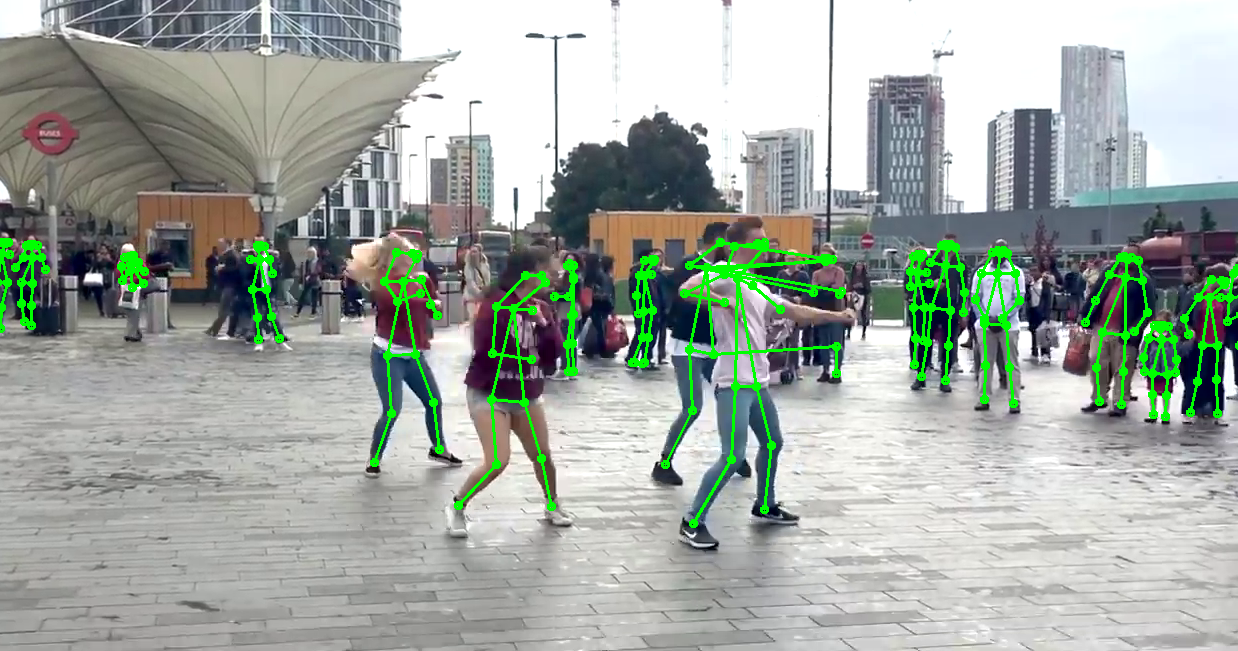trt_pose
 trt_pose copied to clipboard
trt_pose copied to clipboard
No result
I convert pynb to python but I got no output:
from trt_pose.parse_objects import ParseObjects
from trt_pose.draw_objects import DrawObjects
import PIL.Image
import torchvision.transforms as transforms
import cv2
import time
from torch2trt import TRTModule
import torch2trt
import torch
import trt_pose.models
import json
import trt_pose.coco
import os
import sys
with open('human_pose.json', 'r') as f:
human_pose = json.load(f)
topology = trt_pose.coco.coco_category_to_topology(human_pose)
num_parts = len(human_pose['keypoints'])
num_links = len(human_pose['skeleton'])
model = trt_pose.models.resnet18_baseline_att(
num_parts, 2 * num_links).cuda().eval()
MODEL_WEIGHTS = 'resnet18_baseline_att_224x224_A_epoch_249.pth'
model.load_state_dict(torch.load(MODEL_WEIGHTS))
WIDTH = 224
HEIGHT = 224
data = torch.zeros((1, 3, HEIGHT, WIDTH)).cuda()
model_trt = torch2trt.torch2trt(
model, [data], fp16_mode=True, max_workspace_size=1 << 25)
OPTIMIZED_MODEL = 'resnet18_baseline_att_224x224_A_epoch_249_trt.pth'
torch.save(model_trt.state_dict(), OPTIMIZED_MODEL)
model_trt = TRTModule()
model_trt.load_state_dict(torch.load(OPTIMIZED_MODEL))
t0 = time.time()
torch.cuda.current_stream().synchronize()
for i in range(50):
y = model_trt(data)
torch.cuda.current_stream().synchronize()
t1 = time.time()
print(50.0 / (t1 - t0))
mean = torch.Tensor([0.485, 0.456, 0.406]).cuda()
std = torch.Tensor([0.229, 0.224, 0.225]).cuda()
device = torch.device('cuda')
def preprocess(image):
global device
device = torch.device('cuda')
image = cv2.cvtColor(image, cv2.COLOR_BGR2RGB)
image = PIL.Image.fromarray(image)
image = transforms.functional.to_tensor(image).to(device)
image.sub_(mean[:, None, None]).div_(std[:, None, None])
return image[None, ...]
parse_objects = ParseObjects(topology)
draw_objects = DrawObjects(topology)
if __name__ == '__main__':
v_f = sys.argv[1]
cap = cv2.VideoCapture(v_f)
while(True):
ret, image = cap.read()
if ret:
data = preprocess(image)
cmap, paf = model_trt(data)
cmap, paf = cmap.detach().cpu(), paf.detach().cpu()
# , cmap_threshold=0.15, link_threshold=0.15)
counts, objects, peaks = parse_objects(cmap, paf)
print(counts)
print(objects)
draw_objects(image, counts, objects, peaks)
cv2.imshow('res', image)
cv2.waitKey(1)


How to resolve this issue that different person keypoints connnected with each other
Hi, bro, i also convert ipython to python script, and got no result ,the objects printed out also shows:
tensor([[[-1, -1, -1, ..., -1, -1, -1],
[-1, -1, -1, ..., -1, -1, -1],
[-1, -1, -1, ..., -1, -1, -1],
...,
[-1, -1, -1, ..., -1, -1, -1],
[-1, -1, -1, ..., -1, -1, -1],
[-1, -1, -1, ..., -1, -1, -1]]], dtype=torch.int32)
How do you make it normally show skeleton like the image you post, thanks !
How to resolve this issue that different person keypoints connnected with each other
you should set link_threshold larger.
Hi, bro, i also convert ipython to python script, and got no result ,the
objectsprinted out also shows: tensor([[[-1, -1, -1, ..., -1, -1, -1], [-1, -1, -1, ..., -1, -1, -1], [-1, -1, -1, ..., -1, -1, -1], ..., [-1, -1, -1, ..., -1, -1, -1], [-1, -1, -1, ..., -1, -1, -1], [-1, -1, -1, ..., -1, -1, -1]]], dtype=torch.int32) How do you make it normally show skeleton like the image you post, thanks !
Hi,Have you solved this issue? I encountered the same problem!
Hell,how have you solved this problem when convert live_demo.pynb to python but got no output,I have the same issue,thanks very much!!!
who solved the problem?
haha, the secret is to resize the frame into 224,224 before calling model_trt
Hi @gongysh2004, @jinfagang
Could you please share your code if you were able to make it work ? Did you use openCV to capture the webcam or did you use the jetcam repo ?
Anyway, I would really appreciate if you could help me make it work :-)
Cheers
@lweingart ` import os import time import json import cv2 import torchvision.transforms as transforms import PIL.Image from trt_pose.draw_objects import DrawObjects from trt_pose.parse_objects import ParseObjects import trt_pose.coco import trt_pose.models import torch from torch2trt import TRTModule from PIL import Image
WIDTH = 256 HEIGHT = 256 mean = torch.Tensor([0.485, 0.456, 0.406]).cuda() std = torch.Tensor([0.229, 0.224, 0.225]).cuda() device = torch.device('cuda')
with open('human_pose.json', 'r') as f: human_pose = json.load(f)
topology = trt_pose.coco.coco_category_to_topology(human_pose) num_parts = len(human_pose['keypoints']) num_links = len(human_pose['skeleton'])
OPTIMIZED_MODEL = 'resnet50_baseline_att_256x256_A_epoch_249_trt.pth' print(OPTIMIZED_MODEL)
model_trt = TRTModule() model_trt.load_state_dict(torch.load(OPTIMIZED_MODEL))
parse_objects = ParseObjects(topology) draw_objects = DrawObjects(topology)
def preprocess(image): global device device = torch.device('cuda')
image = PIL.Image.fromarray(image)
image = transforms.functional.to_tensor(image).to(device)
image.sub_(mean[:, None, None]).div_(std[:, None, None])
return image[None, ...]
def process_img(image): ori_image = image.copy() image = cv2.resize(image, (WIDTH, HEIGHT)) data = preprocess(image) start = time.time() start_model = time.time() cmap, paf = model_trt(data) print("FPS model: ", 1.0/(time.time() - start_model)) cmap, paf = cmap.detach().cpu(), paf.detach().cpu() counts, objects, peaks = parse_objects(cmap, paf)#, cmap_threshold=0.15, link_threshold=0.15) print("FPS: ", 1.0/(time.time() - start)) draw_objects(ori_image, counts, objects, peaks) return ori_image
def predict_image(path = '1.jpg'): image = cv2.imread(path) img = process_img(image) cv2.imshow("as", img) cv2.waitKey() cv2.destroyAllWindows()
def predict_video(path_video): print(path_video) if os.path.exists(path_video): print("exist path video") vid = cv2.VideoCapture(path_video)
while(True):
ret, frame = vid.read()
if not ret:
# print("no frame")
break
frame = process_img(frame)
frame = cv2.resize(frame, (frame.shape[1]//2, frame.shape[0]//2))
cv2.imshow("as", frame)
if cv2.waitKey(25) & 0xFF == ord('q'):
break
vid.release()
cv2.destroyAllWindows()
predict_video('Hog_2.mp4') ` Hope it help you!
Hello @tucachmo2202,
Thank you very much for your help. I will try it tomorrow :-)
Thank again
Hello @tucachmo2202,
Out of curiosity, where did you find your 'resnet50_baseline_att_256x256_A_epoch_249_trt.pth' model, did you train it yourself ?
Hello @tucachmo2202,
Out of curiosity, where did you find your 'resnet50_baseline_att_256x256_A_epoch_249_trt.pth' model, did you train it yourself ?
Hi, Yes. I retrained it. But the model is not accurate too much and more slow because larger input.
Hello @jinfagang, hello everyone,
May I ask you how you did to obtain this image? https://user-images.githubusercontent.com/21303438/105796494-e92c6c80-5fc9-11eb-9504-5a0832458c66.png
What I mean is that I want to be able to draw these skeletons on images from a webcam, and they are larger than 224x224. If I resize them after drawing the skeletons, the result is aweful. However, looking at the image you posted, it seems that you found a solution to apply the drawing on images of arbitrary size.
Could I ask you, or anyone, if they have a solution to offer to do this ?
Thank you very much in advance
Cheers
Hello everyone,
I realised that my question was stupidly simple to answer. If anyone would be interested, you just need to have the neural net work on the 224x224 image, and call draw_objects on the real image.
Cheers